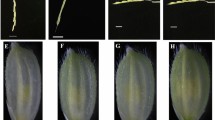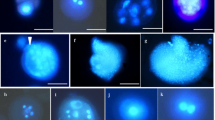Abstract
To establish an efficient asparagus microspore culture system, experiments were conducted to investigate the effects of medium components, period of cold pretreatment for flower buds, and period of anther co-culture on culture response. All factors affected the frequency of asparagus microspore division and the yields of microspore-derived calli. The best results were obtained by pretreating genotype G459 flower buds at 4 °C for 7–9 days, co-culturing anthers with shed microspores for 14 days, and including 6% sucrose, 2 mg l–1α-naphthaleneacetic acid and 1 mg l–1 N6-benzylaminopurine in the culture medium. After 4 days of culture, most shed microspores contained starch-like bodies and died. The 2% of shed microspores lacking these structures divided to produce microcalli. For the best treatments in the different experiments, about 140 calli per 100 anthers were recovered. Cultured on four different regeneration media, 19.6–21% and 3.9–8.0% of microspore-derived calli produced shoots and embryos, respectively, and ultimately plantlets, among which 49% were haploid, 34% diploid, 4% triploid and 11% tetraploid.
Similar content being viewed by others
Author information
Authors and Affiliations
Additional information
Received: 3 September 1998 / Revision received: 25 November 1998 / Accepted: 5 December 1998
Rights and permissions
About this article
Cite this article
Peng, M., Wolyn, D. Improved callus formation and plant regeneration for shed microspore culture in asparagus (Asparagus officinalis L.). Plant Cell Reports 18, 954–958 (1999). https://doi.org/10.1007/s002990050690
Issue Date:
DOI: https://doi.org/10.1007/s002990050690




